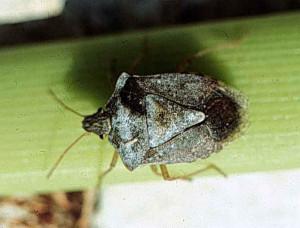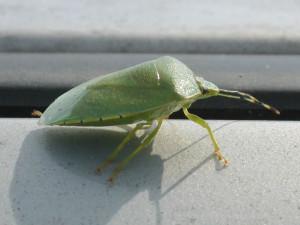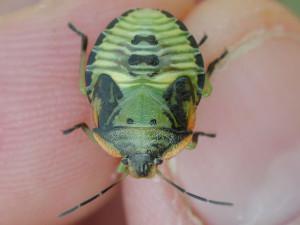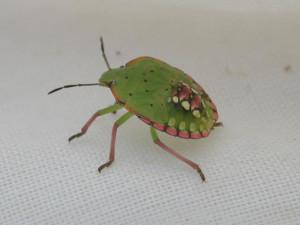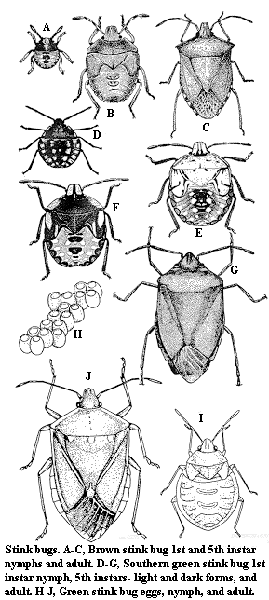Biology
These shield-shaped bugs can be found in fields across the state, but usually do not reach pest levels in areas outside of the mid and southern coastal counties and adjoining areas. Three kinds of stink bugs may become abundant in soybean, the green stink bug (Acrosternum hilare Say), southern green stink bug (Nezara viridula L.), and brown stink bug (Euschistus servus Say).
Of the three species, the southern green stink bug has the greatest damage potential. However, overwintering southern green stink bugs are affected by cold weather and seldom become a problem in seasons following winters with temperature periods in the teens. The green and brown stink bugs are more cold-hardy and are present each year. A single species is seldom a problem, however, as a complex of stink bugs, they may reach damaging levels. Stink bugs affect fruiting soybeans and reach peak populations in late August through early October, primarily in mid-September. They may be active until frost.
The invasive brown marmorated stink bug may also be found in your soybean field and in or around your home. More information can be found in Brown Marmorated Stink Bug in the Landscape and in the Home, in the publication Brown Marmorated Stink Bug, Biology And Management In Mid-Atlantic Soybeans, or in the webcast Impact and Management of Brown Marmorated Stink Bug in Mid-Atlantic Soybean.
Injury and Damage
Stink bugs are important late-season insect pests of the soybean seed and reduce both yield and quality by their feeding. Although “grain soybeans” are affected by stink bug, “seed soybeans” and “vegetable soybeans” are more vulnerable in terms of severity and frequency of loss. Stink bugs have piercing mouth parts and feed on tender terminals, blooms, pods, and developing seeds within pods. When feeding, both adults and nymphs (immatures) inject digestive saliva into the plant which helps liquefy plant tissues for easy extraction by the bug. The salivary fluid causes direct tissue injury and also can carry bacterial organisms that grow within the seeds. Feeding may also create an avenue for pathogen entry into the plant. Germination and general seed quality can be affected by stink bug feeding. Additionally, feeding injury during early seed formation can result in aborted seeds and undersized, deformed seeds.
Both the adult and immature (nymphs) stink bugs are found in soybean fields. Stink bugs are highly attracted to fruiting soybeans and colonization of fields is influenced by planting date and cultivar maturity. At our latitude, there appears to be two to three generations (depending on the season and location) and damaging populations usually do not occur until at least late August. Stink bug nymphs are not very mobile and remain in the vicinity of the egg cluster through the third growth stage (for about 2 weeks). However, the larger nymphs (fourth and fifth instars) and the adults are more mobile. Small stink bug nymphs may be mostly black (southern green stink bug), reddish brown to pale green with black and white stripes on the abdomen (green stink bug), or pale yellow to tan with brown spots (brown stink bug). Large nymphs (last two stages) are pale green with pink, black, and white markings (southern green stink bug); green with yellow and black markings or yellow with black markings (green stink bug); or dull yellow/tan (brown stink bug). Adults are green/yellow green with red bands on the antennae (southern green stink bug), bright green with black bands on the antennae (green stink bug), or brown with a yellow underside (brown stink bug). The brown stink bug looks similar to a predatory stink bug, the spined soldier bug, but has rounded shoulders whereas the soldier bug has sharp, pointed shoulders.
Scouting
Stink bugs often occur in an uneven distribution within soybean fields. Adults move into fields from the edges and, therefore, may be more numerous along the margins during a colonization period. Eggs are laid in masses and after hatching the young nymphs remain in the same area until reaching an intermediate growth stage. Because of this clumping, individual scouting samples may give artificially high, or low, counts of small stink bugs, but these samples may not reflect the general stink bug population in the field. As stink bugs develop into larger nymphs and adults, they move throughout the field. Adult stink bugs are strong fliers and will move to soybeans of differing maturities as they enter the bloom / pod fill period.
Insecticide Management
Management of stink bugs relies on scouting and thresholds to identify where and when treatment is necessary, and the use of insecticides. Thresholds are based on row width, price of beans, and sampling method used. Use the online stink bug in soybean threshold table before making a management decision. Both of the green stink bug species are relatively easily controlled with acephate and pyrethroid insecticides but the brown stink bug is less easily affected. Brown stink bug should only be treated with bifenthrin or acephate at higher rates and sometimes this does not give the desired results. Good application technique is very important when attempting to reduce stink bug abundance.
Publication date: March 17, 2020
N.C. Cooperative Extension prohibits discrimination and harassment regardless of age, color, disability, family and marital status, gender identity, national origin, political beliefs, race, religion, sex (including pregnancy), sexual orientation and veteran status.

